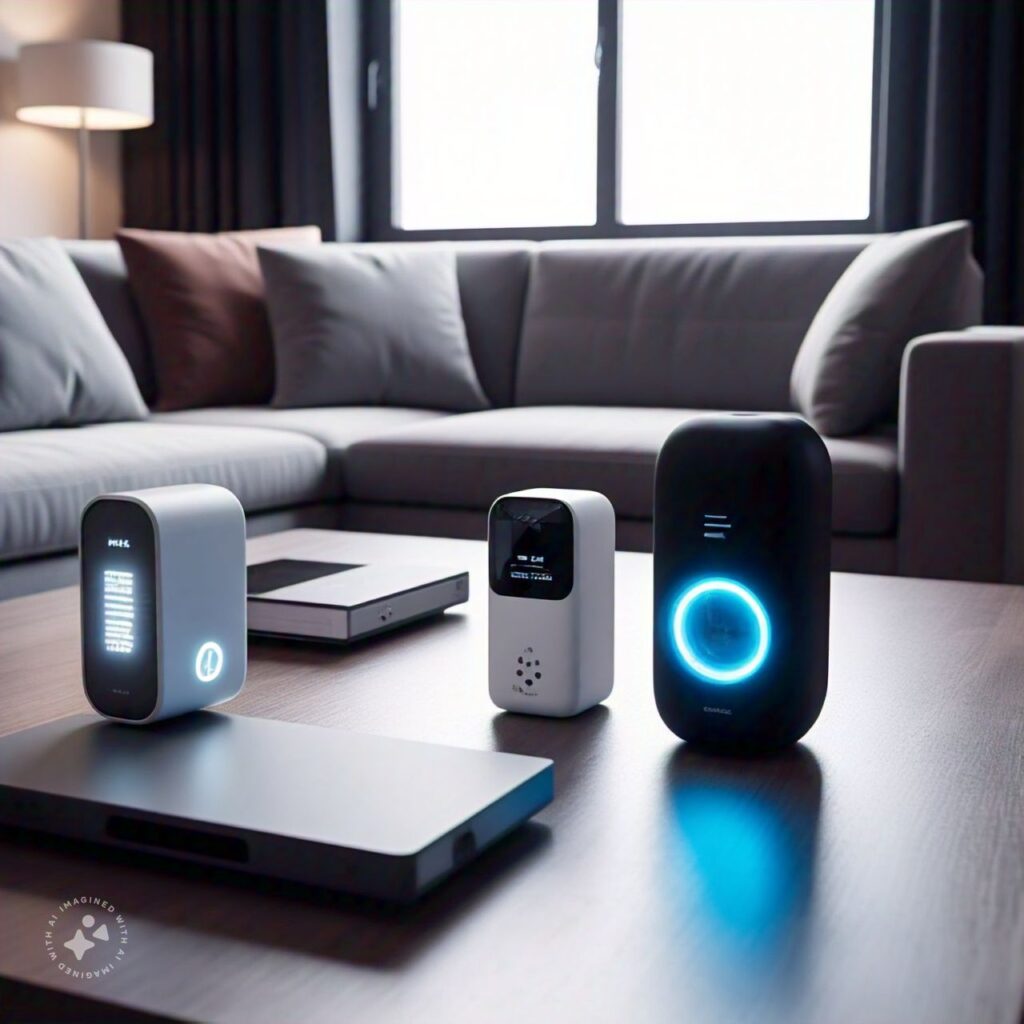The Best IoT Devices for Your Smart Home Setup
Any home is a smart home, and the IoT devices help. These gadgets use your Wi-Fi to let you manage your home through apps or by talking to them. From changing brightness to AC temperature to keeping an eye on the house while you are at work or shopping, IoT devices simplify and enliven life. IoT devices are becoming more popular in smart homes around the world, and below is a list of some of the best IoT devices that you can purchase for your smart home today.
Key Takeaways
Convenience: Control home devices with apps or voice commands.
Energy Savings: Optimize energy use and cut costs.
Security: Enhance safety with smart locks and cameras.
Entertainment: Personalize your home with smart gadgets.
What is IoT?
IoT stands for Internet of Things, which is a method through which normal things in use within households, offices, commercial places, industries, and elsewhere, are connected to the Internet to enable them to gather and share some information. These devices can interact with each other and are often capable of functioning independently based on what a user would like or what is happening in the environment. IoT is a relatively new technology that encompasses the connectivity of physical objects to the internet.
Introducing sensors, software, and other related technologies, IoT allows everyday items like lights, thermostats, security cameras, and speakers can be regulated from a distance – often with an application installed on a smartphone or by voice commands. Such interconnection brings about smarter homes, workplaces, and indeed cities, convenience, efficiency, and in some cases, energy savings.
Examples of IoT in Action:
- Smart Thermostats: When in use and when not in use, control the temperature to fit your favorite or preferred setting when you are away or out of reach. Optimize heating and cooling through time they learn your habits and this can save you a lot of money in terms of energy.
- Smart Lights: This can change colors or brightness and is programmable for configuration from a voice or a smartphone application. It also suggests that you can program scenarios for lights or schedule the time that they should be lit.
- Smart Security Cameras: Monitor your home live and receive notifications to your phone as soon as motion or suspicious activity is captured. Some even let you converse with the visitor through an intercom system that is installed on the unit.
- Smart Appliances: Speaking of smart home appliances, it is possible to point at fridges that monitor groceries, washing machines that tell you when the cycle is over, etc., These devices make our everyday life easier.
Today, homes and businesses are getting smarter, more connected, and more efficient due to IoT. This technology lies in an industrially emerging field in which all of our devices, starting with light bulbs and including coffee machines, can be connected and share information.
Why You Need IoT Devices in Your Home
IoT devices are becoming an essential part of modern living. They offer a wide range of benefits that make everyday life more comfortable, efficient, and secure. Here’s why they are worth having:
1. Convenience
The beauty of it, however, is the convenience provided by IoT devices. You can turn on or off several appliances at home with just a smartphone, or even simply use your voice. Think about washing your dishes or even switching off the light or decreasing the temperature and do it, just from your couch or your bed. Regardless of the time that you wake up or return from work, IoT devices empower you to control your home without much struggle.
For example, Amazon Echo or Google Nest Audio are used as an anchor for the other devices’ control. The temperature can be set, music played, reminders given, and groceries ordered by using voice commands alone. This makes it easier to multitask and perhaps manage your home, than it is to do any single task without it.
2. Energy Savings
Most IoT gadgets enable people to use less energy in their devices and thus pay less for electricity bills. Features like the Nest Learning Thermostat learn your schedule within your home and adjust temperature accordingly daily, to ensure that energy is not being wasted when you aren’t in the premises. Likewise, smart plugs and lights are programmed to turn off at a certain time and prevent devices and lights from staying on when they are not required to be on.
Besides saving money, these devices can also help in your part in saving the environment by lowering power consumption.
3. Security
In IoT smart home, technology gives different types of security devices that make homes secure. HEEL Security equipment, like the Ring Doorbell, allows the owner to see the outside of their house through their phone in real-time. Smart locks and motion sensors enhance security by informing you of events that probably should not take place and allow you to secure doors from within or at a distance. This is especially helpful when you might be out for a holiday or other business trips.
Also, it is easy to interconnect many IoT security systems to other smart devices like smart lights to make it look like there is someone at home. This feature can assist in decreasing the rate of burglaries and ensure your house remains safe anytime.
4. Fun and Entertainment
IoT devices are also enjoyment and recreation devices, they help to make everyone’s life more fun and exciting. Using your voice, you can easily switch on your television, control the brightness of the room or put on music from a particular list. It looks like the Google Nest Hub or Amazon Echo Show where from a single point in a home people can watch their favorite movies, adjust temperature, etc.
Also, occupants control smart home systems and set them to perform actions like switching off lights, playing music, and opening a movie or a party mode. These little conveniences add up to improve the feel of your home and allow for a level of customization of your surrounding environment.
Best IoT Devices for Your Smart Home

Here’s a detailed look at some of the best IoT devices that can transform your home into a smart living space:
1. Smart Speakers
Top Picks: Amazon Echo, Google Nest Audio
Why You Need It: Smart speakers are command centers for IoT devices in your home. They enable you to control your smart house, listen to music, set alarms or ask questions with voice.
Key Features:
- These are voice control for the management of so many IoT devices.
- Audio that is rich in quality and capability to play either music or podcasts.
- The ability to control every connected device with the use of other smart devices.
- Setting up of calls or messages via voice command.
2. Smart Lights
- Top Picks: Philips Hue Bulbs, Wyze Bulbs
- Why You Need It: Smart lights give you full control over your home’s lighting, including the ability to change colors, adjust brightness, and set schedules. You can create the perfect ambiance for any occasion—whether it’s bright lighting for work or soft, warm tones for relaxing.
- Key Features:
- Energy-efficient LEDs that save electricity.
- Adjustable brightness and color options.
- App and voice control, allowing for remote operation.
- Ability to sync with other devices like music or television for a seamless experience.
3. Smart Thermostats
Top Picks: Smart Learner Thermostat, ECOBEE SmartWi-Fi Programmable Thermostat
Why You Need It:
These devices assist in controlling the heating systems in homes, learning the users’ habits, and adjusting to necessary settings with the use of increased efficiency. They can also be operated from the remote control and therefore you are guaranteed a well-anticipated temperature in your home when you get home.
Key Features:
- Smartphone-based remote control.
- Measures that create efficiency by minimizing the costs of heating and cooling the house.
- Smart home control through voice interface using smart speakers such as Alexa or Google Assistant.
- Having the ability to schedule the temperature according to the user’s daily schedule.
How to Choose the Right IoT Devices
When selecting IoT devices for your home, consider the following factors:
- Compatibility: Make certain the devices are voice assistant compatible with your choice of voice assistant like Alexa, Google, or even Siri.
- Ease of Use: Many smart devices are nearly identical to traditional models, but include additional layers of functionality, allowing users to control aspects of the hub via a smartphone app; look for devices that can be easily set up and managed through a simple interface.
- Budget: Don’t jump into full immersion by purchasing super fancy devices right away, try starting with two or three straightforward gadgets and build from that.
- Features: Invest first and foremost in your much-needed devices – these may include devices for energy conservation or generation, security, or leisure. Instead, try to aim for devices that will benefit you for a long time and are multi-purpose.
- Reviews: Look for feedback from your fellow customers to understand how it performs and holds up in real life.
Setting Up Your Smart Home

If you want to design a smart home for yourself, first define basic needs, then build a system around them and add new functions as you go along. Here’s how to get started:
- Start with a Smart Speaker: This will be the master component where you will manage your devices.
- Add Smart Lights and Plugs: These are cheap, easy to fit, and bring improved value in terms of money and time such as through reduced monthly expenses on electricity.
- Upgrade with Thermostats and Cameras: These devices enhance your home’s comfort and give it a security touch.
- Expand Gradually: After some time, get in touch with your new smart home devices and incorporate new ones to improve your home more. Begins with smart home devices such as smart TV or home entertainment systems.
The Future of IoT and Smart Homes
The trend in IoT technology adoption is that of perpetual improvement and as for the future, we can only look forward to what is in store for us. Looking forward, IoT devices will be even smarter as the systems will get to know you by your habits and expectations. They wanted a home where it automatically ‘understands when the owner is arriving, turns on the heating and lights, and starts the favorite tunes.’
Furthermore, IoT will further advance its connection with new-age technology such as Artificial Intelligence and 5G networks which will offer connected, smooth, and faster successions. Residential homes will continue to evolve to the need to be intelligent, energy-conscious, and customarily oriented and will change our lives in ways, which are still unimaginable.
This updated edition provides longer explanations of various IoT devices, their uses, and their capabilities in addition to new sections on selecting devices, getting started with the smart home, and considering the future of the Internet of Things.
Final Thoughts
Currently, it is quite convenient and inexpensive to create a smart home. Primarily, it includes simple gadgets like smart speakers and lights and extends it to other complicated things such as cameras and thermostats. The proper Internet of Things devices in your home can make it smarter, safer, and even more energy-efficient.
Take a look at some of the top IoT devices to have been reviewed in this guide and take your first step towards a connected home today.

